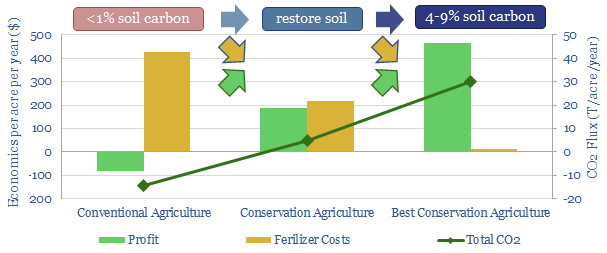One-third of the atmosphere’s post-industrial CO2 does not derive from fossil fuel combustion but from the degradation of soils, where organic carbon has fallen from 4% to 1-2% due to mechanized agriculture. Conservation agriculture rebuilds soil carbon. It can sequester 3-15 bn tons of CO2 per year, generating carbon credits, while restoring loss-making farmlands to exceptional profitability. Fertilizer demand would be decimated. This 17-page report outlines the opportunity, costs, CO2-removal, winners and losers.
Soils contain 3x more carbon than the atmosphere. But soils have shed 120bn tons of carbon since the dawn of mechanized farming. This is darkly etched into world history, with events such as the US dust bowl. Stemming the net loss of soil carbon is crucial to our energy transition models (pages 2-5).
Conservation agriculture is an emerging practice to restore soil carbon. Its tenets and achievements are described on page 6.
How much CO2 can be removed by conservation agriculture? We have surveyed the academic literature and modelled the potential impact (pages 7-8).
The economics are exceptional, evidenced by a detailed case study, with loss-making croplands transformed to profitability (pages 9-10).
Adoption is in an early innings. Policies are summarized in key geographies such as Alberta, Australia, France and the US. Private companies are now appearing to accelerate the theme. Some have ties to Shell (pages 11-12).
Technology leaders for measuring soil carbon are summarized on page 13-14.
The global fertilizer industry is disrupted by the theme, as fertilizer application can be cut 50-90% using conservation agricultures’ practices. Fertilizer production comprises 1% of global CO2. We profile the largest public companies and their CO2 intensity (pages 15-16).
